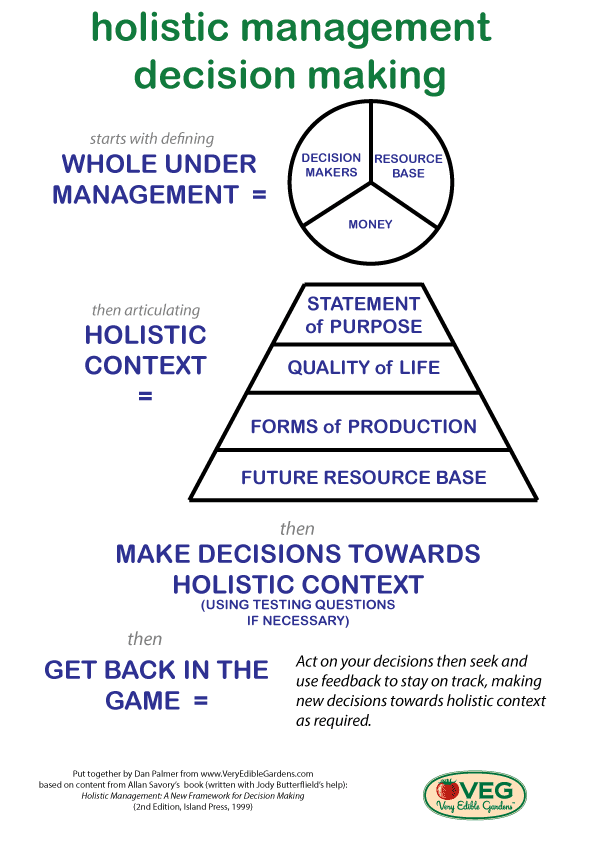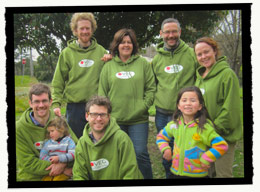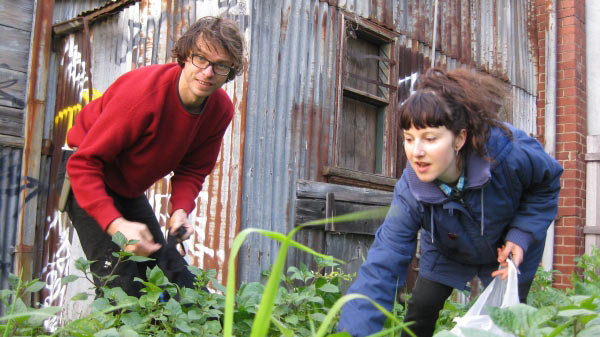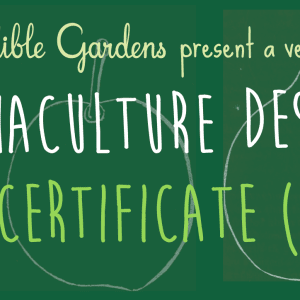NOTE: Dan has HUGELY evolved and updated this content since it was first written in 2014 – check out on his new site www.HolisticDecisionMaking.org
For the last several years, VEG has been using something called Holistic Management as its core operating system. It has been a game changer and a blessing, and here, as well as sharing how we have applied it, I want to have a go at explaining what it is. After a brief introduction, I will go through some of its core aspects, using the VEG example to:
- communicate the essence of what VEG is about and how it rolls
- make the application of Holistic Management in a non-farming context more accessible to others, and
- share our particular applications and adaptations of Holistic Management in the interests of getting feedback and advice from more experienced practitioners.
We see a need for clear, useful information about holistic management for several reasons. One is that so many of the families, businesses, organisations, and projects we consult to have gaps in areas that managing holistically has the potential to very powerfully fill. Another is that again and again the thing that people get the most value from, and get the most excited about applying, whether on our permaculture design courses or other courses and workshops, is Holistic Management. It cuts to the chase of what so many of us today need. Okay, okay, I know what you’re thinking – “hurry the heck up and tell me what it is!”
What is Holistic Management(R), anyway?
Holistic Management is a framework for empowering decision making that is socially, environmentally, and economically sound in the short, medium and long term. Now that’s a bit of mouthful, I know. It is also a pretty big call, when you think about it. Humans are notorious for making decisions based on a short-term social, environmental, or economic outcome that has unintended short, medium, and long term consequences in the other two areas.
An all-too-common example is a business that makes decisions towards financial outcomes, or a non-profit that makes decisions towards environmental outcomes, where both do so in a way that burn out the individuals involved (an unintended social consequence). Sooner or later, it is game over, and people give up, exhausted and demoralised.
In the following clip my co-director Adam and I talk about how we were fast falling into this trap, and then give a taste for how Holistic Management helped us turn things around:
If we were all making socially, environmentally and economically good decisions that were sound in the short, medium and long term, (even if say 25% of the time!) the world would be going in a radically different and more beautiful direction than it is right now. Imagine a world filled with groups or organisations that simultaneously strengthened individual and social health and happiness, ecosystem health and diversity, and the local economy, both now and long into the future. This is a world most of us want to live in, and it is precisely what Holistic Management is about empowering. It is nothing if not ambitious, though as we will see, it is also nothing if not practical and not that hard if you can give it just a little time and discipline.
Holistic Management’s history
 Holistic Management was founded and formulated by Allan Savory, and it all started with his quest to figure out what was behind the world’s rapid and ongoing transformation into desert. After a long and unexpected journey he realised that the only common factor that underlies desertification the world over is human decision making. He then developed Holistic Management as a framework for empowering land managers to make land management decisions that halt and indeed reverse desertification.
Holistic Management was founded and formulated by Allan Savory, and it all started with his quest to figure out what was behind the world’s rapid and ongoing transformation into desert. After a long and unexpected journey he realised that the only common factor that underlies desertification the world over is human decision making. He then developed Holistic Management as a framework for empowering land managers to make land management decisions that halt and indeed reverse desertification.
This is an important point, for the emphasis of materials on Holistic Management, whether print, audio, video or otherwise, has almost exclusively been on Holistic Management in a land-management, farming, or ranching context, and in particular on understanding how the nature of the relationship between grazing animals and grasslands can send the land backwards or forwards. For Allan, this focus has been essential in that until we reverse the global haemorrhaging that is desertification, we are on track to not be around to think about doing anything else.
However, in his seminal Holistic Management: A New Framework for Decision Making (Second Edition), Allan introduces “the way forward that I found and subsequently developed with the help of many others” as “a new decision-making process that gives us the ability to design and to plan the future we want while ensuring that the environment can sustain it.” He then explains that this “decision-making process can serve to manage a farm, a national park, or a city’s water supply, or one’s personal life, a household, a corporation, or organisation of any kind. It also can be used to diagnose the underlying cause of many problems, to assess a variety of policies, and to make research more relevant to management needs” (p. 4-5).
forward that I found and subsequently developed with the help of many others” as “a new decision-making process that gives us the ability to design and to plan the future we want while ensuring that the environment can sustain it.” He then explains that this “decision-making process can serve to manage a farm, a national park, or a city’s water supply, or one’s personal life, a household, a corporation, or organisation of any kind. It also can be used to diagnose the underlying cause of many problems, to assess a variety of policies, and to make research more relevant to management needs” (p. 4-5).
Thus at its core Holistic Management is a design making process applicable to any thing that is being managed by at least one human being making decisions. In the rest of this article, I’ll be focusing on Holistic Management at this general level, where farming is but one of any number of possible applications.
The process summarised
I would now like to launch right into the process of getting started with Holistic Management. Let us start with this beautiful short clip in which Allan Savory, using a farming example, gives a wonderful summary and feel for the general process:
Next, check out another, even shorter clip of the late Holistic Management educator Bruce Ward putting it in his words (The 20 seconds starting at 2m:16s is the most concise and compelling summary I’ve seen and sometimes I watch it several times over).
Okay, with these lovely flavours in mind, check out this diagram I put together to explain the broad strokes. We’ll then go through each step using VEG as our example.

Step One – Curling up inside a nice Whole
As the diagram shows, step one is Defining the Whole Under Management. Let’s get this little bit of jargon out of the way. Holistic Management implies a thing that is holistically managed. That thing is a whole, where a whole is any entity managed by at least one person. Thus it might be an individual life, a couple, a family, a project, a company, a festival, an organisation, or whatever. Obviously we are all involved in lots of wholes.
Step One in the process is getting some clarity going on as to what the relevant whole under management actually is. Distinguishing it from the rest of the universe, if you like. This step is often straightforward and involves making a note of the following three aspects of any whole under management.
First, however, check out Bruce Ward introducing these three aspects (note he uses the term “economic whole” where I prefer just straight out “whole under management”):
Decision makers
Decision makers are anyone who has veto power over decisions pertaining to managing the whole under consideration. If the whole is your life, then you are the decision maker, in a family the decision makers would be the caregivers and any children old enough to have input on decisions (my three-year-old daughter is right on the threshold).
In the case of VEG, the owners and directors (currently Adam Grubb and myself), are the core  decision makers, yet we include the other six VEG team members as decision makers in that they do have significant input into many decisions we make, and of course we all directly deal with the outcomes of decisions and contribute to their success or failure.
decision makers, yet we include the other six VEG team members as decision makers in that they do have significant input into many decisions we make, and of course we all directly deal with the outcomes of decisions and contribute to their success or failure.
Resource base
Some people don’t like the word resource, but I’m okay with it in this context, where it simply means anything you have access to that does or could help you in achieving whatever you set out to achieve. In VEG’s case we listed all the people such as past customers, friends and so on, that we know are a support to VEG. Next we listed resources like relevant qualifications and skill sets. Finally we listed all physical resources, such as vehicles, warehouse space, land, tools, machines we know we could borrow, anything we could potentially draw on or leverage toward getting things done.
This step has always been empowering for me, my fellow decision makers, and those decision makers I’ve supported in defining their own whole under management. We so often never take the time to audit or appreciate just how many resources we have available to us.
Money
The final aspect considered in defining the whole under management is money. Like it or not, money is an important consideration in most wholes today, and here you make a list of what sources of money you have – be it cash on hand or in the bank, access to credit, and so on. It is not to imply you will ever necessarily use these lines of credit, but simply to acknowledge that they are there as possibilities.
Okay, there you have it – you’ve defined your whole under management and you’re ready for the next step. Do appreciate, however, how critical this first step is. You will struggle to manage anything you haven’t defined.
Anyways, to check out the next step please visit: Part Two: Articulating an Holistic Context
NOTE: Dan has HUGELY evolved and updated this content since it was first written in 2014 – check out on his new site www.HolisticDecisionMaking.org
Note: Holistic Management(R) is a registered trademark of Holistic Management International and is used by permission



